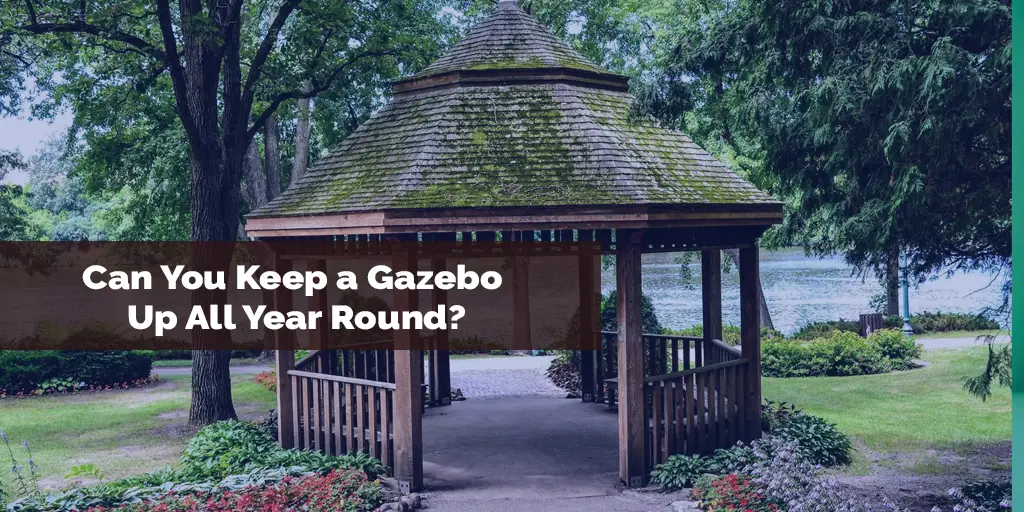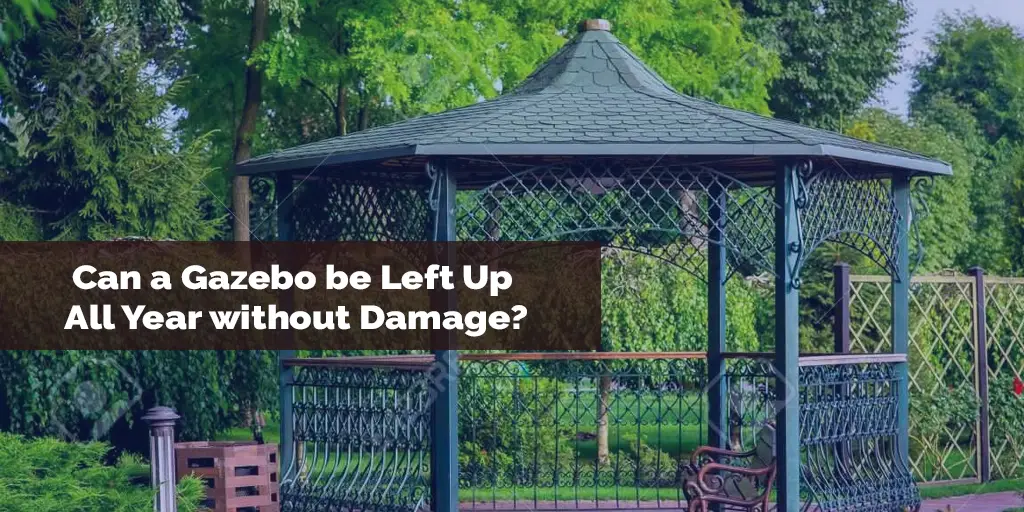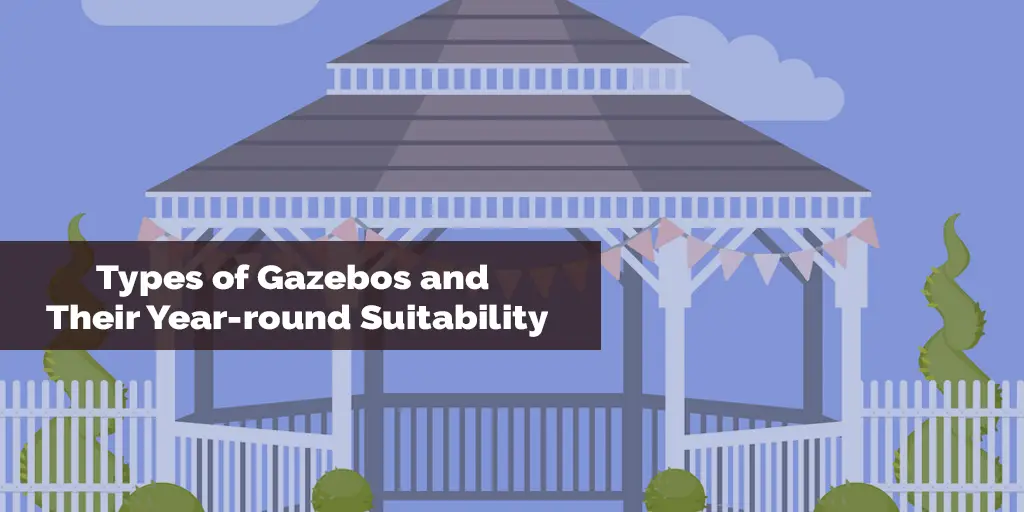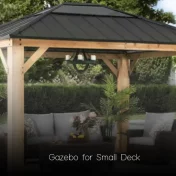For many homeowners, gazebos are more than just an attractive feature in the garden. They offer a sanctuary from the sun, a shield from the rain, and a cozy retreat during colder months.
But a recurring question that often surfaces is: “Can you keep a gazebo up all year round?”

The ability to withstand various weather elements largely depends on the type of gazebo you own.
Whether it’s a hardtop gazebo that offers robust protection against snow and ice or a soft top gazebo better suited for milder climates, understanding the nuances of your gazebo’s material and design is crucial.
If you live in an area with frequent strong winds, you’ll need to ensure that your gazebo stays anchored.
On the other hand, if heavy snowfall is a regular occurrence, you’d have to remove snow periodically to ensure that your gazebo remains in top shape.
In this comprehensive guide, we’ll dive deep into the world of gazebos, exploring various designs from the pop up gazebo to the more permanent structures.
We’ll discuss the challenges posed by different weather conditions and provide actionable tips to make your gazebo more weather resistant.
So, whether you’re contemplating whether to leave your gazebo up during high winds or curious about the durability of top gazebos in the market, we’ve got you covered.
Key Takeaways:
- Discover the differences between hardtop gazebos and soft top gazebos and their ability to withstand harsh weather.
- Learn practical tips to ensure your gazebo stays firm against strong winds and other challenging conditions.
- Understand why some gazebos are left up all year and the maintenance required to do so.
Can a Gazebo be Left Up All Year without Damage?

The short answer is: it depends. The ability to withstand harsh weather is largely contingent on the type of gazebo you have and the care you provide.
It’s not just about whether you can keep a gazebo up all year round but also about ensuring it remains in optimal condition.
Several factors come into play:
- Material: Hardtop gazebos, typically made of metal or polycarbonate, offer robust protection against most weather conditions, from scorching sun to snow and ice. Soft top gazebos, while more flexible and often more affordable, may need extra care during extreme weather.
- Geographical Location: If you live in an area with heavy snowfall, frequent high winds, or intense sun, these will directly impact how your gazebo stays throughout the year.
- Maintenance: Regular checks, timely repairs, and appropriate preventive measures, such as removing snow or reinforcing the structure against strong winds, can greatly extend the lifespan of your gazebo.
Case Study: Mr. Anderson, a resident of Colorado, shared his experience with his soft top gazebo. Despite living in an area known for its snowfall, he managed to keep his gazebo up all year round.
The trick? “Regular maintenance and proactive measures, like adding extra weights and consistently removing snow, ensured my gazebo remains undamaged,” he explains.
Checklist for All-year Gazebo Maintenance:
- Weather-resistant coatings: Especially for soft top gazebos, consider applying protective coatings that resist UV rays and repel water.
- Anchor it well: No matter where you live, ensuring your gazebo stays anchored against unexpected strong winds is crucial.
- Snow removal: If you live in an area prone to snow, ensure that snow is removed from your gazebo’s roof promptly. Snow accumulation can lead to structural damage.
- Regular inspections: At least once a month, inspect your gazebo for any wear and tear, especially before and after harsh weather conditions.
By considering these factors and diligently following maintenance routines, it’s entirely feasible to ensure that your gazebo remains sturdy and beautiful all year round.
Types of Gazebos and Their Year-round Suitability

The type of gazebo you choose plays a significant role in determining its ability to withstand various weather conditions. Let’s break down some common types:
Vinyl Gazebos
Vinyl gazebos have become increasingly popular due to their durability and low maintenance requirements.
They’re resistant to both moisture and insects, making them an excellent choice for those who want to leave their gazebo up year-round.
Pros:
- Weather resistant: Vinyl is naturally resistant to both rain and UV rays.
- Low maintenance: Unlike wood, vinyl doesn’t require regular staining or sealing.
Cons:
- Might not have the natural aesthetic appeal that some wood gazebos offer.
Maintenance Tips:
- Clean with mild soap and water to keep it looking new.
- Ensure that the structure is anchored well, especially in areas with high winds.
Untreated Wood Gazebos
While untreated wood gazebos offer a natural and rustic appeal, they require more maintenance if you plan to keep them up throughout the year.
Pros:
- Natural look enhances the beauty of outdoor spaces.
Cons:
- Susceptible to weather damage and insects.
- Requires regular treatments to maintain its appearance.
Maintenance Tips:
- Consider treating the wood to make it more weather-resistant.
- Regularly inspect for signs of insect damage or rot.
Fabric Gazebos
Fabric gazebos, often referred to as pop up gazebos, are portable and offer flexibility. However, their suitability for year-round use can be limited based on the fabric quality.
Pros:
- Portable and easy to set up.
- Available in various designs and colors.
Cons:
- Not as durable as hardtop or vinyl gazebos.
- Fabric can fade with prolonged exposure to the sun.
Maintenance Tips:
- Ensure the fabric is UV resistant to prevent fading.
- After heavy rain, allow the fabric to dry out completely to prevent mold or mildew.
Treated Wood and Composite Wood Gazebos
Treated wood and composite wood gazebos combine the beauty of natural wood with enhanced durability. They’re designed to resist various elements, making them suitable for those who wish to leave their gazebo up all year.
Pros:
- Enhanced resistance against rot and insects.
- Composite wood offers consistency in appearance.
Cons:
- Treated wood may need regular re-treatments.
Maintenance Tips:
- For treated wood, regular inspections to determine if re-treatment is necessary.
- Composite wood can be cleaned with mild soap and water.
Temporary or Portable Gazebos
These are best for occasional use. While they offer flexibility, they might not withstand harsh weather conditions like permanent gazebos.
Pros:
- Flexibility to move and store.
Cons:
- Limited durability against harsh weather conditions.
Maintenance Tips:
- Always anchor them well, even if they’re meant for short-term use.
- Store them in a dry place when not in use.
Each type of gazebo has its unique features, and understanding these can help you make an informed decision on whether or not you can keep your gazebo up year-round.
The right care and maintenance further ensure your gazebo remains in top condition, regardless of its type.
Special Considerations for Gazebos
No matter the type of gazebo you have, certain external factors can influence its longevity and appearance. Being aware of these and taking necessary precautions can make a world of difference.
Wind Factors
High winds can be a gazebo’s worst enemy, especially if it’s not anchored properly. The impact of strong winds can range from minor damage, such as tearing the gazebo’s canopy, to major issues like toppling the entire structure.
Tips:
- Anchoring: Ensure your gazebo is anchored securely to the ground. Use weights or stakes for added stability.
- Positioning: If possible, position your gazebo in a location shielded from prevailing winds.
- Regular Checks: After a particularly windy day, inspect your gazebo for any potential damage.
Snow and Rain
Snow and ice accumulation can put extra weight on your gazebo, especially on the roof. Prolonged exposure to moisture from rain can also lead to mold, mildew, and rot in certain gazebo types.
Tips:
- Snow Removal: Regularly remove snow from your gazebo’s roof to prevent structural damage.
- Waterproofing: Ensure that your gazebo’s material is treated to be water-resistant. This is especially crucial for fabric and untreated wood gazebos.
- Drainage: Ensure the area around your gazebo has proper drainage to prevent water accumulation.
Sun Exposure
Prolonged exposure to the sun can lead to fading, especially for fabric gazebos. UV rays can also weaken certain materials over time.
Tips:
- UV Protection: Look for gazebos with UV-resistant materials. Consider adding a UV-resistant coating if your gazebo isn’t already treated.
- Positioning: If possible, position your gazebo in an area that receives some shade during the hottest parts of the day.
Being mindful of these considerations and acting proactively can significantly enhance the life of your gazebo, ensuring it remains a centerpiece in your garden for years to come.
You May Also Enjoy Reading:
Maintenance Tips for Gazebos
Whether you decide to keep your gazebo up all year round or just during specific seasons, maintenance is key.
A well-maintained gazebo not only looks appealing but also serves its purpose for a longer time. Here are some general maintenance tips applicable to most gazebos:
- Regular Cleaning: Dust, mold, bird droppings, and other debris can accumulate on your gazebo over time. Clean your gazebo with mild soap and water at least once a month, ensuring that you rinse and dry it properly.
- Inspect for Damage: Before and after extreme weather conditions, or at least once a month, thoroughly inspect your gazebo. Check for any signs of wear, tear, or damage. Promptly attend to any issues you find.
- Protect Against Pests: Especially for wooden gazebos, ensure that you regularly check for termites or other pests. Consider using pest repellents or consulting with a pest control expert if you notice any infestation.
- Waterproofing: If your gazebo isn’t naturally water-resistant, consider applying a waterproof sealant. This is especially crucial for untreated wooden gazebos.
- Reinforce Anchoring: Regularly check the stakes, weights, or other anchoring systems you’ve used. If you anticipate high winds or a storm, consider adding extra weights or anchors.
- Replace Worn Out Parts: Over time, certain parts of your gazebo, especially the canopy for soft-top gazebos, might wear out. Instead of waiting for them to become completely unusable, replace them as soon as they start showing significant signs of wear.
- Store During Extreme Weather: If you have a portable or pop-up gazebo and anticipate extreme weather, consider disassembling and storing it safely. This can significantly enhance its lifespan.
- Seek Professional Help: If you’re unsure about any aspect of your gazebo’s maintenance or notice something amiss, don’t hesitate to consult with a professional. Regular professional checks can also be beneficial.
By adhering to these maintenance guidelines, you can ensure that your gazebo remains not only a beautiful addition to your outdoor space but also a durable one.
Conclusion
Gazebos, with their elegance and functionality, have long been cherished additions to gardens and backyards.
The question of whether you can keep a gazebo up all year round largely depends on its type, the local weather conditions, and how well it’s maintained.
From hardtop gazebos that can withstand snow and ice to pop-up ones best suited for occasional use, each has its unique set of advantages and challenges.
With the right knowledge, proactive measures, and regular maintenance, it’s possible to ensure that your gazebo remains a beloved fixture in your outdoor space for years to come.
Frequently Asked Questions (FAQs)
What’s the best material for a gazebo if I live in an area with heavy snowfall?
Hardtop gazebos, especially those made of metal or polycarbonate, are best suited for areas with heavy snowfall. They can bear the weight of snow better than soft-top gazebos.
How often should I inspect my gazebo?
A monthly inspection is a good rule of thumb. However, after extreme weather conditions like a storm or high winds, an immediate check is advisable.
Can I add extra protection to my soft top gazebo to make it more weather-resistant?
Absolutely! Applying UV-resistant coatings, waterproofing treatments, and ensuring it’s anchored well can enhance the weather resistance of a soft top gazebo.
I have a portable gazebo. Should I store it during winter?
If you live in an area with harsh winter conditions, it’s advisable to store your portable gazebo during those months. This will enhance its longevity.
My gazebo was damaged by strong winds. What should I do?
First, inspect the extent of the damage. Minor damages might be repairable with DIY fixes. However, for significant damages, consult with a professional or consider replacing the damaged parts.
With this comprehensive guide, we hope to have addressed all your concerns and queries about keeping a gazebo up year-round.
Remember, with the right care and attention, your gazebo can remain an oasis of relaxation and beauty in all seasons.



